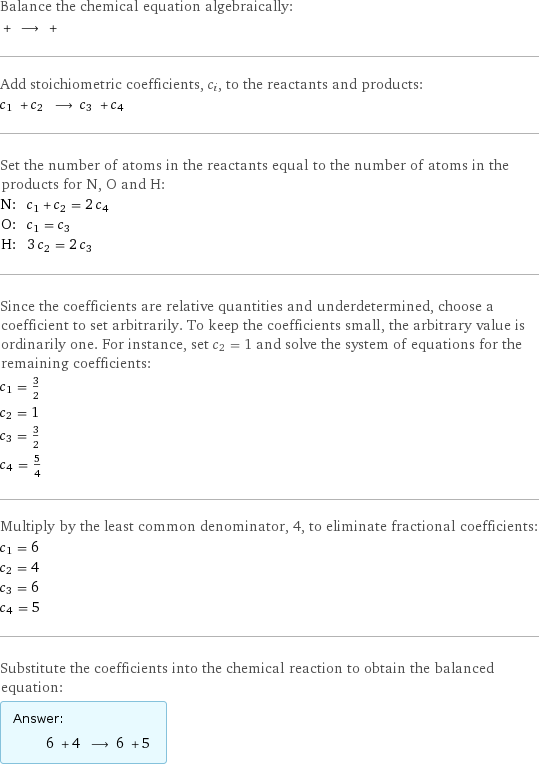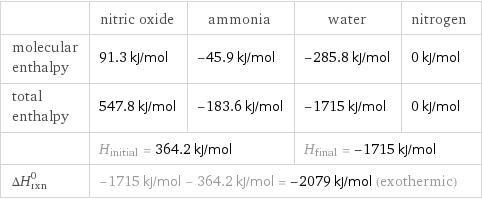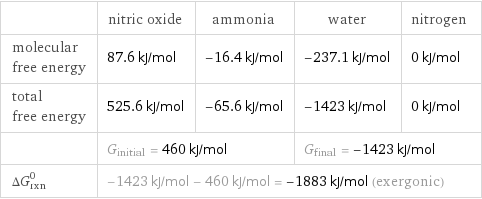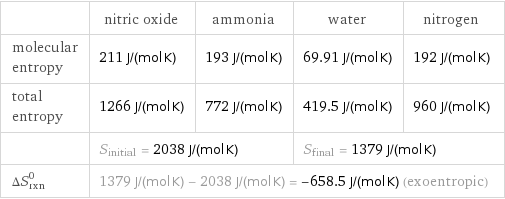Input interpretation

nitric oxide + ammonia ⟶ water + nitrogen
Balanced equation

Balance the chemical equation algebraically: + ⟶ + Add stoichiometric coefficients, c_i, to the reactants and products: c_1 + c_2 ⟶ c_3 + c_4 Set the number of atoms in the reactants equal to the number of atoms in the products for N, O and H: N: | c_1 + c_2 = 2 c_4 O: | c_1 = c_3 H: | 3 c_2 = 2 c_3 Since the coefficients are relative quantities and underdetermined, choose a coefficient to set arbitrarily. To keep the coefficients small, the arbitrary value is ordinarily one. For instance, set c_2 = 1 and solve the system of equations for the remaining coefficients: c_1 = 3/2 c_2 = 1 c_3 = 3/2 c_4 = 5/4 Multiply by the least common denominator, 4, to eliminate fractional coefficients: c_1 = 6 c_2 = 4 c_3 = 6 c_4 = 5 Substitute the coefficients into the chemical reaction to obtain the balanced equation: Answer: | | 6 + 4 ⟶ 6 + 5
Structures

+ ⟶ +
Names

nitric oxide + ammonia ⟶ water + nitrogen
Reaction thermodynamics
Enthalpy

| nitric oxide | ammonia | water | nitrogen molecular enthalpy | 91.3 kJ/mol | -45.9 kJ/mol | -285.8 kJ/mol | 0 kJ/mol total enthalpy | 547.8 kJ/mol | -183.6 kJ/mol | -1715 kJ/mol | 0 kJ/mol | H_initial = 364.2 kJ/mol | | H_final = -1715 kJ/mol | ΔH_rxn^0 | -1715 kJ/mol - 364.2 kJ/mol = -2079 kJ/mol (exothermic) | | |
Gibbs free energy

| nitric oxide | ammonia | water | nitrogen molecular free energy | 87.6 kJ/mol | -16.4 kJ/mol | -237.1 kJ/mol | 0 kJ/mol total free energy | 525.6 kJ/mol | -65.6 kJ/mol | -1423 kJ/mol | 0 kJ/mol | G_initial = 460 kJ/mol | | G_final = -1423 kJ/mol | ΔG_rxn^0 | -1423 kJ/mol - 460 kJ/mol = -1883 kJ/mol (exergonic) | | |
Entropy

| nitric oxide | ammonia | water | nitrogen molecular entropy | 211 J/(mol K) | 193 J/(mol K) | 69.91 J/(mol K) | 192 J/(mol K) total entropy | 1266 J/(mol K) | 772 J/(mol K) | 419.5 J/(mol K) | 960 J/(mol K) | S_initial = 2038 J/(mol K) | | S_final = 1379 J/(mol K) | ΔS_rxn^0 | 1379 J/(mol K) - 2038 J/(mol K) = -658.5 J/(mol K) (exoentropic) | | |
Chemical names and formulas

| nitric oxide | ammonia | water | nitrogen Hill formula | NO | H_3N | H_2O | N_2 name | nitric oxide | ammonia | water | nitrogen IUPAC name | nitric oxide | ammonia | water | molecular nitrogen